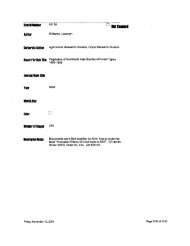Chapter 2: The Military Use of Herbicides in Vietnam - Special ...
Chapter 2: The Military Use of Herbicides in Vietnam - Special ...
Chapter 2: The Military Use of Herbicides in Vietnam - Special ...
You also want an ePaper? Increase the reach of your titles
YUMPU automatically turns print PDFs into web optimized ePapers that Google loves.
was an <strong>in</strong>tegral part <strong>of</strong> the unit, but was not mounted on the pallet. W<strong>in</strong>g<br />
booms (3.8 cm <strong>in</strong> diameter and 6.7 m <strong>in</strong> length) extended from outboard<br />
eng<strong>in</strong>e nacelles toward the w<strong>in</strong>g tips. A short tail boom (7.6 cm <strong>in</strong><br />
diameter, 6.1 m <strong>in</strong> length) was positioned centrally near the aft cargo door.<br />
Each aircraft normally had a crew <strong>of</strong> three men: the pilot, co-pilot<br />
(navigator), and flight eng<strong>in</strong>eer (console operator). Dur<strong>in</strong>g the peak<br />
activity <strong>of</strong> RANCH HAND operations (1968-1969), approximately 30 UC-123K<br />
aircraft were employed. However, many other squadrons <strong>of</strong> non-RANCH HAND C-<br />
123 aircraft were rout<strong>in</strong>ely used throughout South <strong>Vietnam</strong> <strong>in</strong> transport<br />
operations.<br />
<strong>The</strong> control <strong>of</strong> malaria and other mosquito-borne diseases <strong>in</strong> South<br />
<strong>Vietnam</strong> necessitated an extensive aerial <strong>in</strong>secticide application program <strong>in</strong><br />
order to control these vector <strong>in</strong>sects. from 1966 through 1972, three C-123<br />
aircraft were used to spray malathion, an organophosphate <strong>in</strong>secticide.<br />
<strong>The</strong>se aircraft could be dist<strong>in</strong>guished from the herbicide-spray<strong>in</strong>g aircraft<br />
because they were not camouflaged. <strong>The</strong>se aircraft rout<strong>in</strong>ely sprayed<br />
<strong>in</strong>secticide adjacent to military and civilian <strong>in</strong>stallations, as well as <strong>in</strong><br />
areas where military operations were <strong>in</strong> progress, or about to commence.<br />
Approximately 10 to 12 percent <strong>of</strong> all herbicides used <strong>in</strong> South <strong>Vietnam</strong><br />
was dissem<strong>in</strong>ated by helicopter or ground application equipment. Generally,<br />
helicopter crews were not assigned to herbicide spray duties on a full-time<br />
basis and rotated the spray<strong>in</strong>g duties with other mission requirements. <strong>The</strong><br />
military UH-1 series <strong>of</strong> helicopters, deployed by the Air Force, the Army,<br />
and Navy units, generally sprayed the herbicides. <strong>The</strong> most common spray<br />
systems used were the H1DAL and AGRINAUTIGS units. <strong>The</strong>se units were<br />
<strong>in</strong>stalled <strong>in</strong> or removed from the aircraft <strong>in</strong> a matter <strong>of</strong> m<strong>in</strong>utes because<br />
they were "tied down" to <strong>in</strong>stalled cargo shackles and aircraft modifications<br />
were not required for their use. Each unit consisted <strong>of</strong> a 760-liter tank<br />
and a collapsible 9.8 m spray boom. <strong>The</strong> unit was operated by manual<br />
controls to control the flow valve and a w<strong>in</strong>dmill brake. Generally, each<br />
helicopter had three crew members.
















